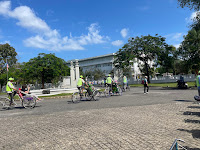2/25/2024
We get up early for a morning flight to the city of Hue, a former capital of Vietnam. After an early breakfast with David and Linda, we boarded a bus for a ride to Hanoi’s airport.
 |
| Phuoc Duyen pagoda |
Built on the northern bank of the Perfume River in 1601, Thien Mu Temple (meaning Temple of the Celestial Lady) is one of the historic monuments that have earned Hue a place in UNESCO’s World Heritage Sites. The temple’s iconic seven-story Phuoc Duyen pagoda is the unofficial symbol of the city.
 |
| Perfume River from Thien Mu |
 |
| Inside of Thien Mu |
Hue and the Thien Mu Temple were major organizing points for the Buddhist movement. The car used by Thich Quang Duc is on display at the temple’s museum.
Leaving the Thien Mu Temple, we board dragon boats for a cruise down the Perfume River to our hotel. Traditionally, these long, narrow, canoe-like boats were human-powered and engineered for race competitions. Our boats are canopied, wider, and motored to haul people.
 |
| Dragon boats |
The Perfume River gets its name from fragrant flowers that fall from upstream orchards into the water during autumn and emit a subtle perfume-like aroma. And of course, no boat ride would be complete without the ubiquitous local vendors selling their clothing and souvenir items while we enjoy refreshments, the beautiful weather, and the cruise.
After checking in at the La Residence Hotel and Spa, a former governor’s residence, we enjoy lunch in the hotel’s restaurant and then board cyclos (SIC lows), a bike-like progeny of rickshaws, for a ride to the Imperial City in the citadel of the city of Hue. A walled enclosure within the citadel, the Imperial City served as the former imperial capital of Vietnam during the Nguyen Dynasty.
 |
| Heading out in our cyclos |
It contains the palaces that housed the imperial family, as well as shrines, gardens, and villas for mandarins. Within the Imperial City lies the Purple Forbidden City, to which access was restricted to the imperial family. The city was constructed in 1803 under Emperor Gia Long.
 |
| Hue's Citadel |
As we toured the citadel complex, our local guide recounted its military importance and history and provided colorful details of the lives of the imperial families that resided there. We marveled at the designs and artistry of the structures, particularly the ceramic artwork that was so prevalent.
 |
| Moat around Citadel |
 |
| Main gate of Citadel |
 |
| Thai Hoa Palace (Emperor's Residence) |
 |
| Palace closeup |
 |
| Fine porcelain work |
 |
| A park entrance |
 |
| The local beer! |

No comments:
Post a Comment